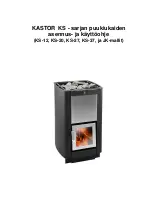
VGZ-003 / 20120327.0
PB65XL /
Page 13
MAINTENANCE & SERVICE HINTS
2. When burning wood, use hardwood rather than
softwood. Burn only seasoned (<20% humid-
ity by weight) wood. Do not mix green wood with
seasoned wood. Wood that hisses, sizzles, and
blackens prior to igniting should be considered too
green. Green or wet wood rapidly builds up creosote
and reduces heat output by up to 25%.
2.
Avoid smothering the fire with too much fuel.
Too much fuel loaded at one time will create
heavy, volatile gas which can coat the chimney
with creosote-forming tar.
3. Burn the stove with the spin draft control wide open
for 10-15 minutes every time fresh fuel is loaded
into the stove. Do not load more than ¼ to ½ of the
fuel capacity at one time. Loading too much fuel at
once will cause excessive smoke which contains
creosote. Mature fires or coals produce very little
creosote-producing smoke.
4. Burn with the spin draft control open for several
minutes at numerous intervals throughout the day,
being careful not to over fire the unit. Following this
process will help to warm the chimney and reduce
the amount of creosote forming condensation within
the chimney.
5. Establish a routine for the handling of fuel, firing,
and operating the stove. Check daily for creosote
build up until experience shows how often you need
to clean for safe operation. Be aware that the hotter
the fire, the less creosote is deposited and weekly
cleanings may be necessary in mild weather even
though monthly cleanings may be enough in the
colder months.
WARNING: IN CASE OF CHIMNEY FIRE
(1) CLOSE AIR INLET CONTROL AND FLUE
PIPE DAMPER. (2) GET OUT OF THE HOUSE
(3) CALL THE FIRE DEPARTMENT.
SOOT - Formation & need for Removal
CAUTION: RISK OF FIRE. When coal is burned,
the products of combustion combine with
moisture to form a soot residue which accumu-
lates in the flue lining. When ignited, this soot
makes an extremely hot fire.
The chimney connector and chimney should
be inspected at least once every two months
during the heating season to determine if a soot
buildup has occurred.
If soot has accumulated, it should be removed
to reduce the risk of a chimney fire.
Additionally, coal combustion by-products like sul-
phur dioxide, sulphur trioxide and others can corrode
stainless steel and masonry chimneys. It is important
to inspect and clean chimney on a regular schedule.
CHIMNEY INSPECTIONS – The chimney connec-
tor and chimney should be inspected
at the beginning
of and
at least twice a month during the heating
season to determine if a creosote or soot buildup has
occurred.
Chimney fires burn very hot. If any part of the stove,
chimney or chimney connector should glow red, reduce
the fire by closing the damper and spin draft control and
immediately call the fire department.
CAUTION: A CHIMNEY FIRE MAY CAUSE
IGNITION OF WALL STUDS OR RAFTERS
WHICH WERE ASSUMED TO BE A SAFE
DISTANCE FROM THE CHIMNEY. IF A
CHIMNEY FIRE HAS OCCURRED, HAVE YOUR
CHIMNEY INSPECTED BY A QUALIFIED
EXPERT BEFORE USING AGAIN.
A fire in the stove may be smothered by
pouring a large quantity of coarse salt, baking soda, or
cool ashes on top of the fire.
S TOV E J O I N T S – R e q u i r e d Tu n e - u p .
This stove is manufactured with cast iron
components.
IT DOES NOT HAVE WELDED SEAMS.
Periodic “tune up” may be required by refilling and/
or replacing the cement/joint mortar along the seams
where the cast iron components meet.
Call us at 1-866-667-8454
NorthlineExpress.com
www.NorthlineExpress.com


































